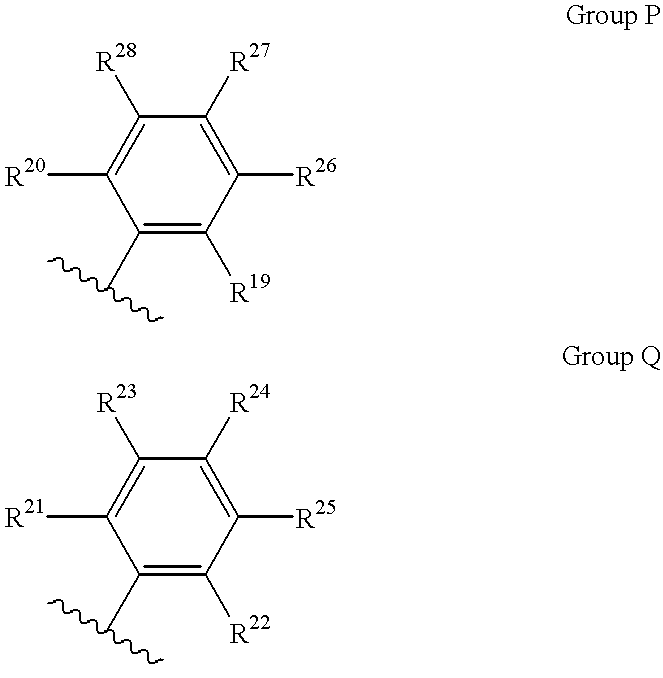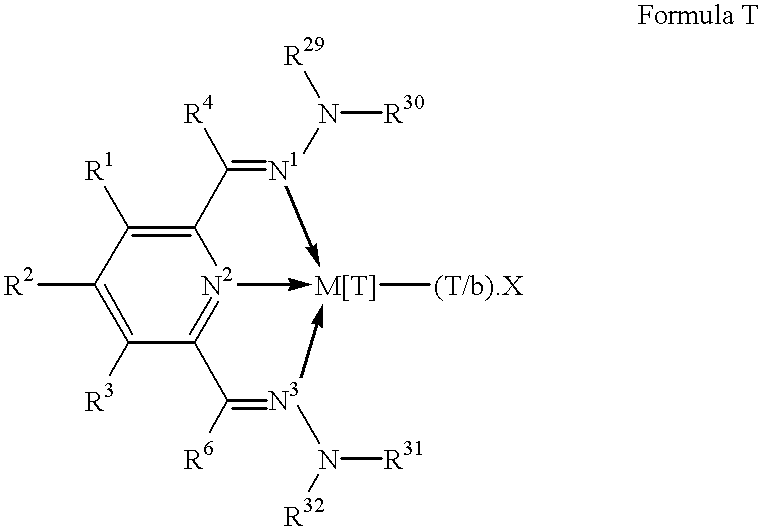Polymerization catalysts
a technology of polymerization catalyst and catalyst, which is applied in the direction of physical/chemical process catalyst, group 8/9/10/18 element organic compound, chemical/physical process, etc., can solve the problems of large sensitivity, large quantity of expensive alumoxanes, and small residual catalyst in the produced polymer
- Summary
- Abstract
- Description
- Claims
- Application Information
AI Technical Summary
Benefits of technology
Problems solved by technology
Method used
Image
Examples
example 1a
Preparation of 2,6-diacetylpyridine bis (2,4,6-trimethylphenyl amine) FeCl.sub.2 Complex
4 g of 2,6-diacetylpyridine, 10.32 ml of 2,4,6-trimethylaniline and 0.1 g of p-toluenesulphonic acid monohydrate were added to 300 ml of dry toluene in a 500 ml round bottomed flask. A 20 ml Dean-Stark heavy fractionating column and condenser were attached and the mixture heated with stirring to 160.degree. C. The reaction appeared to have gone to completion in about 3 hours. The solution was then evacuated and 200 ml of methanol added. 2,6-diacetylpyridine bis (2,4,6-trimethylphenyl amine) precipitated out and was isolated by filtration and washed with 3 aliquots of 20 ml of methanol.
3.19 g of iron(II) chloride were weighed into a half liter Schlenk tube and 400 ml of n-butanol added. The suspension was warmed to 90.degree. C. and stirred for 3 hours. 10 g of 2,6-diacetylpyridine bis (2,4,6-trimethylphenyl amine) was added as a solid at 80.degree. C. The reaction was stirred for 1 hour then at 2...
example 1b
Preparation of the Catalyst
The equipment used for calcining the silica support was composed essentially of a vertical quartz cylinder, 75 cm high and 5 cm in diameter, above which was placed a disengagement zone. This calcinator was equipped with a fluidisation grid made from porous quartz and positioned in the lower part of the quartz cylinder. It was also equipped with an electrical resistance heater and a supply of fluidising nitrogen.
Into the calcinator maintained at 60.degree. C. and supplied with nitrogen containing less than 2 vpm of water vapour and with a flow rate of 4.7 ml / s, were charged 30 g of silica sold under the trade name of ES70X by Crosfield Catalysts (Warrington, England). Next the calcinator was heated from 60 to 600.degree. C. at a rate of 100.degree. C. / h. The silica was then maintained at 600.degree. C. for 16 hours in the fluidised state. The silica was then cooled to 25.degree. C. and stored under dry nitrogen.
All subsequent operations were carried out in ...
example 1c
Ethylene Polymerisation in the Gas Phase
400 g of polyethylene pellets were introduced into a stainless steel reactor of capacity 2.6 liters equipped with a stirrer and maintained under a nitrogen atmosphere. The reactor was heated to 100.degree. C., stirred at 50 rpm and 0.7 g of silica previously treated with 1.5 mmole / g of triethylaluminium was added as poison scavenger. Next 0.1025 g of the above catalyst (see 1b) was added. Then hydrogen was introduced to pressure the reactor to 0.1 MPa. Finally ethylene was fed until a total pressure of 0.8 MPa was obtained. Ethylene was fed to maintain this pressure throughout the reaction. After production corresponding to 50 g polyethylene per gram of catalyst, the stirring rate was increased to 100 rpm, after the production of 50 g of polyethylene the stirring rate was increased further to 150 rpm and after the production of 100 g of polyethylene the stirring rate was increased further to 200 rpm.
Polymerisation was allowed to continue for 1...
PUM
| Property | Measurement | Unit |
|---|---|---|
| temperatures | aaaaa | aaaaa |
| pressure | aaaaa | aaaaa |
| temperature | aaaaa | aaaaa |
Abstract
Description
Claims
Application Information
 Login to View More
Login to View More - R&D
- Intellectual Property
- Life Sciences
- Materials
- Tech Scout
- Unparalleled Data Quality
- Higher Quality Content
- 60% Fewer Hallucinations
Browse by: Latest US Patents, China's latest patents, Technical Efficacy Thesaurus, Application Domain, Technology Topic, Popular Technical Reports.
© 2025 PatSnap. All rights reserved.Legal|Privacy policy|Modern Slavery Act Transparency Statement|Sitemap|About US| Contact US: help@patsnap.com



